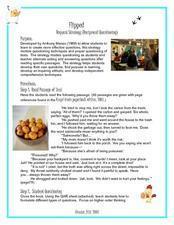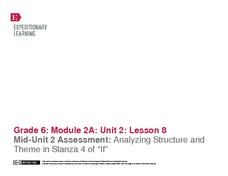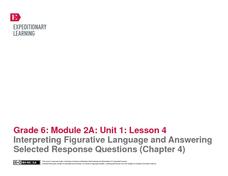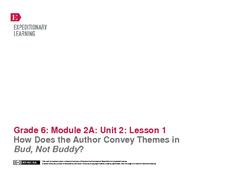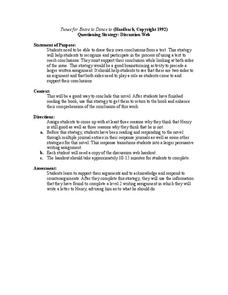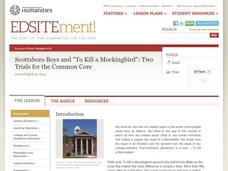Curated OER
Vocabulary Strategy Instructional Routine: Maus I and II
Pogrom, schlepped, meshuga. Kapo, reich, Wehrmacht. As part of a unit study of Maus I and II, readers use a list-group-label (LGL) strategy for vocabulary drawn from Art Spiegelman's famous graphic novels. The focus of the activity is...
Harper Collins
Parrot in the Oven: Response Journal
After completing Chapter 5 of Parrot in the Oven: Mi Vida, readers make text-to-self, text-to-text, and text-to-world connections to Victor Martinez's novel by crafting journal entries addressing comments and questions to characters in...
Curated OER
Flipped: Request Strategy
Break your class into groups and have them read certain passages from the text Flipped (included here). After every two paragraphs, the groups stop to answer the questions included. Which questions provided are right there questions?...
Curated OER
Heart of Darkness: List Group Label Strategy
Heart of Darkness can challenge even the best readers. Here's a pre-reading strategy that will engage class members and provide background and context for Conrad's study of racism, savagery and imperialism. Class members brainstorm,...
Curated OER
Phineas Gage: “This I Believe” Venn Diagrams After Reading Strategy
Difficulties with brain injuries still continue today. After reading Phineas Gage: A Gruesome but True Story About Brain Science, class members read a series of modern personal essays about brain injuries and choose an essay to compare...
EngageNY
Analyzing Structure and Theme in Stanza 4 of “If”
Here is a lesson that provides scholars with two opportunities to stretch their compare-and-contrast muscles. First, learners compare and contrast their experience reading the fourth stanza of If by Rudyard Kipling to listening to the...
EngageNY
Looking Closely at Stanza 3—Identifying Rules to Live By Communicated in “If”
Just as Bud, from the novel Bud, Not Buddy by Christopher Paul Curtis, had rules to live by, so does the poem, If by Rudyard Kipling, but how do the two relate? Pupils delve deep into the poem's third stanza, participate in a grand...
EngageNY
Interpreting Figurative Language and Answering Selected Response Questions (Chapter 4)
To prepare for an assessment of how well individuals are progressing with their ability to identify and analyze figurative language and its effect on tone and meaning, pairs work through Chapter Four of Christopher Paul Curtis'...
EngageNY
How Does the Author Convey Themes in Bud, Not Buddy?
After reading up to chapter 12 of Bud, Not Buddy by Christopher Paul Curtis, scholars read chapter 13 and take part in a grand conversation about the author's writing techniques. Pupils discuss how his writing conveyed literary themes...
EngageNY
Qualities of a Strong Literary Argument Essay
One activity, two essays, and one central theme: qualities of an argument essay. Here, scholars first describe the qualities of an argument essay regarding Bud's rules to live by from the novel Bud, Not Buddy by Christopher Paul Curtis....
Curated OER
Hatchet: Predicting the Outcome Guide
What will happen in Hatchet by Gary Paulsen? Kids read a series of possible events that will occur in the novel and mark whether they agree or disagree with the probability of each event happening.
Curated OER
Tunes for Bears to Dance to: Questioning Strategy, Discussion Web
Readers of Robert Cormier's Tunes for Bears to Dance to are asked to consider the morality of the central character's actions
Curated OER
Shizuko’s Daughter: K-W-L
What would your class like to learn about Japanese culture? Prepare them for a novel unit about Kyoko Mori's Shizuko's Daughter with a KWL chart. After listing what they already know about Japanese culture, they write questions...
Curated OER
Shizuko’s Daughter: Before, During, After Lesson Plan
Shizuko's Daughter by Kyoko Mori presents a vivid picture of Japanese culture and history. As kids read through the third chapter, they find novel-specific vocabulary to enhance their understanding and use context clues to...
Curated OER
Parrot in the Oven: Word Tree - Bonsai or Banyan
What fun! As part of a vocabulary exercise designed for Victor Martinez's Parrot in the Oven: Mi Vida readers create word trees with the trunk representing the root word and the branches representing prefixes that can be added to the...
Novelinks
Where the Red Fern Grows: Graphic Organizer, Story Map
How do you grow a goal from a dream to reality? You make a plan! After reading chapters two and three of Where the Red Fern Grows, learners map how Billy earns his dogs by completing an organizer in pairs and then discussing answers in...
Novelinks
Nightjohn: Bloom's Taxonomy Questions
After completing Nightjohn, Gary Paulsen's young adult novel about slavery set shortly before the Civil War, readers respond to a series of questions crafted to reflect Bloom's taxonomy.
Curated OER
The Grapes of Wrath: Problematic Situation
To prepare for a reading of John Steinbeck's The Grapes of Wrath, kids must prioritize a list of items to take with them on a journey to Texas.
EngageNY
Establishing Structures for Reading: Gathering Evidence about Salva’s and Nya’s Points of View (Reread Chapters 1 and 2)
Readers practice gathering textual evidence to support their understanding of character point of view in A Long Walk to Water by Linda Sue Park. Working with partners, they complete a Gathering Evidence graphic organizer and engage in...
National Endowment for the Humanities
Scottsboro Boys and "To Kill a Mockingbird": Two Trials for the Common Core
Here's a must-have resource for anyone reading To Kill A Mockingbird or using Harper Lee's award-winning novel in a classroom. The packet contains Miss Hollace Ransdall's first-hand, factual account of the trials of the Scottsboro Boys,...
Curated OER
The Boy in the Striped Pajamas: Vocabulary Strategy
In order to truly understand The Boy in the Striped Pajamas, you'll need to provide middle schoolers with background information about the Holocaust. After contributing as many words as they can associate with the Holocaust, such as...
Curated OER
During Reading Strategy for Charles Dickens’ Great Expectations
Readers create a literary scrapbook for one of the characters in Charles Dickens' Great Expectations and fill it with mementoes, journal entries, letters, etc. A great way to get kids to think about characterization.
Novelinks
The Giver: Guided Imagery
Guide your class through the imagery of Lois Lowry's The Giver with a peaceful meditative experience. After you create a serene environment in your class, read through a provided script in which kids sift through their favorite...
Curated OER
Hollywood Magic-The Dream Factory Recreates the Novel
The Great Gatsby, The Jungle and study HRC's Teaching the American Twenties-The Dream Factory are the focus of this lesson, Your students will rewrite a small scene from the novel into a dramatic film scene and then create a modern...




